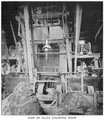English: Silica crushing mill for Manhès-David converter lining.
Text appearing in the book
BESSEMERIZING OF 45 TO 50 PER CENT. COPPER MATTE.
The engravings represented on the following three pages are
made from photographs taken at the converter plant of the Anaconda Copper Mining Company, where a 45 to 50 per cent, matte is converted into about 99 per cent, metallic copper by means of twelve huge converters running continuously and producing over 225 tons of blister copper in twenty-four hours. Since the erection of the first converter in Butte City, 1884, a new era in the history of copper production can be dated, which together with the increased demand and a great many important and highly interesting improvements of late years have carried this metal to the very front.
Operation : At the Anaconda and other modern converting plants the converters are tilted by means of a pinion and vertical rack attached to the piston-rod of a hydranlic cylinder. This improvement over the old style hand power converter has made it possible to increase the capacity of the converter three or four times. The handling is accomplished by means of two powerful electric traveling cranes, capable of lifting the entire converter from its stand and replacing it with another, in less than five minutes time. When taken into consideration that the silica lining in the coverter only lasts for a certain number of hours, it will readily be seen that the rapid exchange of converters is of vital importance to a successful operation.
The matte is charged into the converter vessel from the cupola (remelting furnace) by means of a moveable spout or runway lined with fire-clay, arranged in such a manner that one cupola and one runway will take care of two converters.
To receive the charge, the converter is tilted in a horizontal position. After charging, a powerful air blast is turned on and the converter raised to a vertical position. The blast, which enters the converter through one of the trunnions at a pressure of 11-12 lbs., causes the sulphur and iron contained in the matte to oxidize. Nearly all the sulphur escapes as sulphuric acid gas, while the iron changes into ferrous oxide and combines with the silica in the acid lining of the converter, forming a basic slag, which is poured off into slag-pots by tipping the converter, leaving a pure cuprous sulphide (white metal) in the vessel.
After the slag has been removed, the blowing is resumed until the remaining sulphur is burned off and only metallic copper with a small percentage of silver and gold remains in the converter ready to be cast into ingot moulds.
VIEW OF SILICA CRUSHING ROOM.
The presence of small particles of blister copper in the escaping gases indicates to the converter tender that the charge is ready for casting. Directly back of the converter is located a stack and hood which connects with the dust chamber and receives the sulphurous gases as well as part of the slag discharged from the converter. The silica lining is omposed of about 28 per cent, fireclay and 72 per cent, crushed quartz. The quartz is reduced by crushers and rolls and afterwards mixed with the fire-clay in Chili mills as illustrated in the above engraving. The silica lining, attacked by the ferrous oxide will gradually decrease in thickness until relining and exchange of converter becomes necessary. Twenty-four extra converters are therefore always kept on hand.


